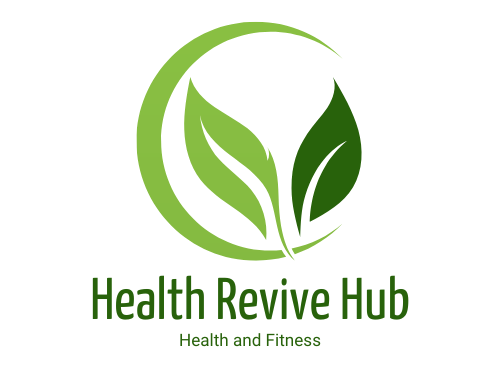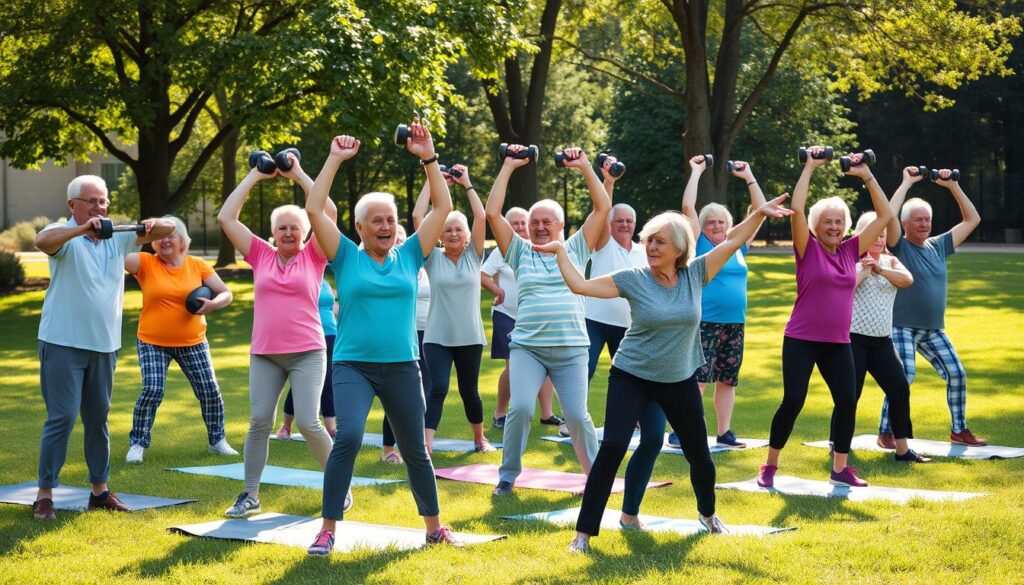When you hit your 50s, it’s key to find senior fitness programs that keep you healthy and full of energy. The right exercises to improve mobility boost your life quality and help with weight control and disease prevention. A good fitness plan can focus on losing belly fat fast, a big worry for many at this age.
Don’t let aging stop you from staying active. In fact, maintaining health over 50 with the right exercises can make your life happier and healthier. Even with age-related changes, there are many exercises that can improve your health, extend your life, and enhance your well-being.
Key Takeaways
- Customized fitness routines are crucial for individuals over 50.
- Targeting exercises that improve mobility and assist in weight management.
- Managing health through tailored senior fitness programs.
- Effective home exercises can help lose belly fat quickly.
- Staying active can prevent chronic illnesses and enhance life quality.
Importance of Staying Active After 50
Staying active after 50 is key for keeping healthy and feeling good. Regular exercise boosts your life quality. It helps you stay independent and enjoy life more.
Benefits of Regular Exercise
Regular exercise has many health benefits for those over 50. It strengthens muscles and improves heart health. It also makes you more flexible and boosts your mood.
- Enhanced Strength: Activities like strength training help keep muscles strong. They also improve bone density, which fights osteoporosis.
- Mental Health: Exercise releases happy hormones. These can help with depression and anxiety, making you feel better.
- Chronic Disease Prevention: Working out regularly lowers the risk of diseases like heart disease, diabetes, and high blood pressure.
Common Misconceptions About Aging and Fitness
There are many wrong ideas about fitness and aging. It’s important to clear up these myths to encourage people to stay active.
- Myth: Seniors should avoid hard exercise.
Reality: Low-impact activities like walking, swimming, and yoga are great. They’re easy on the joints but still very beneficial.
- Myth: Older adults can’t build muscle.
Reality: With the right strength training, older adults can still build and keep muscle.
- Myth: It’s too late to start exercising.
Reality: It’s never too late. Starting an exercise routine at any age can greatly improve your health and support active aging.
Types of Fitness Routines for Older Adults
For older adults, a good fitness routine can really improve their life. It’s important to include exercises that boost heart health, keep muscles strong, and improve flexibility and balance.
Aerobic Exercises
Aerobic exercises like walking, swimming, and dancing are great for seniors. They help keep the heart healthy and can make you feel happier and more energetic. Doing these activities for 30 minutes a day, most days, is very beneficial.
Strength Training
Strength training is key to keeping muscles strong and preventing muscle loss with age. Exercises like using resistance bands, free weights, and bodyweight exercises can boost strength and endurance. Try to do strength training at least twice a week.
Flexibility and Balance Workouts
Stretching and balance exercises are also vital for older adults. Stretching helps with movement, while balance exercises lower the chance of falls. Activities like yoga, tai chi, and Pilates can greatly improve flexibility and balance.
| Type of Exercise | Benefits | Examples |
|---|---|---|
| Aerobic Exercises | Cardiovascular health, mood boost | Walking, swimming, dancing |
| Strength Training | Muscle preservation, strength | Resistance bands, free weights |
| Flexibility and Balance | Improves mobility, reduces fall risk | Yoga, Pilates, stretching |
Creating a Balanced Weekly Workout Plan
Making a balanced weekly workout plan is key for health and fitness over 50. A good routine helps you reach your fitness goals, keeps you motivated, and prevents injuries. Here’s a detailed guide to help you create a great fitness plan.
Sample Weekly Schedule
Here’s a sample exercise schedule for seniors with different routines:
| Day | Activities |
|---|---|
| Monday | 20 minutes of walking (aerobic), 15 minutes of light strength training |
| Tuesday | 30 minutes of cycling (aerobic), 10 minutes of stretching |
| Wednesday | 20 minutes of hiking (aerobic), 15 minutes of balance exercises |
| Thursday | Rest Day or 20 minutes of yoga (flexibility and balance) |
| Friday | 25 minutes of swimming (aerobic), 10 minutes of strength training |
| Saturday | 30 minutes of group dance class (aerobic), 10 minutes of stretching |
| Sunday | Rest Day or 20 minutes of walking (aerobic) |
How to Adjust Timing and Intensity
Adjust your workout intensity based on your fitness level. Personalized fitness plans ensure exercises fit your health and abilities. Start with low-intensity activities and increase as you get more comfortable. Here are tips to adjust your workouts:
- Listen to Your Body: Cut back if you feel uncomfortable or tired.
- Incremental Adjustments: Gradually increase your workout time or effort each week.
- Mix Up Routines: Change your activities to avoid boredom and prevent injuries.
Keeping a balanced workout schedule helps you stay consistent and injury-free. Remember, everyone’s fitness journey is different. What’s important is creating a plan that fits your health and goals.
Tips for Safe Exercising Over 50
As you get older, it’s key to exercise safely to stay healthy. The right exercise can greatly improve your life. Here are some important tips for safe exercising over 50.
Importance of Warm-ups and Cool-downs
Warm-ups and cool-downs are crucial for injury prevention during exercise. Warm-ups get your muscles and joints ready for activity, lowering injury risks. Cool-downs help your body relax after exercise, preventing soreness and stiffness.
Listening to Your Body
It’s vital to listen to your body’s signals for injury prevention during exercise. Your body tells you when something’s off. If you’re feeling tired or in pain, it might be time to adjust or stop. Paying attention to these signs helps avoid injuries and keeps you exercising regularly.
Consulting a Healthcare Provider
Always get medical advice for senior workouts before starting a new routine. A doctor can tailor advice based on your health and fitness level. They help create a workout plan that suits you, ensuring it’s safe and effective.
By following these tips, you can lead an active and healthy life, reducing injury risks.
Effective Strength Training Exercises
Building strength after 50 is key for staying mobile and independent. Low-impact resistance training exercises are great for getting started and staying on track with your fitness goals.
Resistance Band Workouts
Resistance bands are a fantastic choice for low-impact training. They are easy to carry and perfect for beginners over 50. You can adjust the resistance to fit your fitness level.
- Bicep curls: This exercise strengthens your upper arms.
- Leg presses: It boosts lower body strength without putting pressure on your joints.
- Chest presses: This targets your chest and front shoulder muscles.
Bodyweight Exercises
Bodyweight exercises are great for building strength after 50. They need no equipment and can be done anywhere. They use your body weight as resistance, making them low-impact.
- Squats: They improve leg strength and balance.
- Push-ups: They boost upper body strength and engage your core.
- Plank: This strengthens your core and improves your posture.
Free Weights for Beginners
Free weights like dumbbells are effective for starting strength training at 50. They offer a range of motion that machines can’t match. This allows for safe and challenging exercises.
- Dumbbell rows: They improve back strength and posture.
- Overhead presses: They enhance shoulder strength and arm stability.
- Lateral raises: They focus on your shoulder muscles for better upper body definition.
Add these exercises to your routine for the benefits of low-impact resistance training. These exercises help you feel stronger and more confident in your daily life.
Incorporating Aerobic Activities
Staying active is key for those over 50. Cardio exercises improve heart health and let seniors enjoy the outdoors. Let’s look at some aerobic activities that keep you fit and fun.
Walking and Hiking
Walking and hiking are great for heart health. They’re easy on the body and can be adjusted to fit your fitness level. Plus, they let you enjoy nature and fresh air.
Cycling and Swimming
Cycling and swimming are both great for health. Cycling strengthens your legs and boosts your energy. Swimming is special because it’s easy on your joints, perfect for those with arthritis.

Group Classes and Dancing
Joining group classes or dancing is a fun way to stay fit. These social workouts help your mental health by fighting loneliness. Zumba, aerobics, or ballroom dancing are all good for your heart.
| Activity | Benefits |
|---|---|
| Walking and Hiking | Heart health, low-impact, connects with nature |
| Cycling | Strengthens legs, boosts stamina |
| Swimming | Joint-friendly, comprehensive workout |
| Group Classes and Dancing | Social engagement, mental health boost |
The Role of Flexibility and Balance
Keeping flexibility and balance is key for older adults to stay independent and avoid injuries. Adding specific exercises to your routine can greatly help. This leads to a healthier and more active life.
Stretching Routines
Stretching is vital for older adults to keep muscles flexible and reduce stiffness. Simple daily routines include:
- Hamstring stretches: Sit on the edge of a chair and extend one leg forward, reaching toward your toes.
- Shoulder stretches: Reach one arm across your chest and use the other arm to deepen the stretch.
- Quadriceps stretches: Stand and pull one foot toward your buttocks, holding your ankle to stretch the front of your thigh.
Yoga and Pilates
Yoga and Pilates are great for older adults to keep muscles flexible and balanced. They focus on controlled movements and breathing. This improves muscle strength and mental clarity. Adding these to your routine can lead to:
- Enhanced muscular flexibility
- Better posture and alignment
- Reduced risk of chronic conditions such as arthritis or osteoporosis
Tips for Improving Balance
Improving balance is crucial to prevent falls in seniors. Here are some tips to boost your balance:
- Single-leg stands: Practice standing on one leg while holding onto a stable surface for support.
- Tai Chi: Engage in Tai Chi sessions, which involve slow, deliberate movements that improve balance and coordination.
- Heel-to-toe walking: Walk in a straight line, placing the heel of one foot directly in front of the toes of the other foot
By focusing on balance and flexibility exercises, you can enjoy the many benefits of staying active and independent well into your golden years.
Nutrition for Active Adults Over 50
Keeping a balanced diet is key for active adults over 50. As you get older, your body needs different nutrients. These help with muscle recovery and health. Learning to plan your meals can help you reach your fitness goals and feel better.
Essential Nutrients for Muscle Health
For strong muscles, you need certain nutrients. Protein is vital for repairing and building muscle. Eat enough protein from lean meats, dairy, and plant-based foods like beans and lentils.
Omega-3 fatty acids in fish and flaxseeds also help. They reduce inflammation and aid in recovery.

Calcium and vitamin D are important for strong bones. These support muscle function. Get these from dairy, leafy greens, and fortified foods.
Vitamins A, C, and E help with muscle repair. Include fruits and vegetables in your diet for these vitamins.
Meal Planning for Fitness Goals
Good meal prep for active seniors means balanced diets. Plan meals with the right mix of proteins, carbs, and fats. This supports your workouts and keeps energy up.
Here are tips for meal planning:
- Weekly Prepping: Set aside time each week for meal prep. This helps you avoid processed foods.
- Balanced Meals: Mix lean proteins with whole grains and colorful veggies for nutrient-rich meals.
- Hydration: Drink plenty of water and consider electrolyte drinks after exercise to help recover.
By focusing on these dietary needs, you support your fitness goals and overall health. Choose whole foods and avoid too much sugar and saturated fats for a healthy lifestyle.
Staying Motivated and Consistent
Keeping up with workouts can be tough, especially as we get older. But, with the right strategies, you can make exercise a regular part of your day. Here are some tips to help you stay motivated and enjoy fitness.
Finding a Workout Buddy
Having a workout buddy can really help you stick to your exercise plan. They offer motivation, keep you accountable, and might even introduce you to new exercises. Working out with someone who has similar goals makes it more fun and helps you avoid missing sessions.
Setting Realistic Goals
Setting goals that you can reach is key to staying motivated. Break down big fitness goals into smaller, achievable steps. Celebrating each small win boosts your confidence and keeps you going. Make sure your goals are specific, measurable, achievable, relevant, and have a deadline (SMART).
Tracking Your Progress
Keeping track of your progress is vital for staying motivated. Use tools like fitness trackers, journals, or apps to log your achievements. Seeing your progress can be a big motivator. Regularly checking your progress helps you adjust your routine to meet your fitness goals better.
FAQ
What are the best fitness routines for people over 50?
For those over 50, the best routines mix aerobic exercises, strength training, and flexibility workouts. These activities boost heart health, build muscle, and improve balance and mobility.
Why is it important to stay active after turning 50?
Staying active after 50 is key for health, reducing disease risk, and boosting mental well-being. It also keeps physical strength and mobility high. Regular exercise greatly improves life quality as you age.
What are some common misconceptions about aging and fitness?
Many think seniors should avoid hard exercise, can’t build muscle, and exercise is only for the young. But, seniors can greatly benefit from regular exercise, especially strength training, which helps keep muscle and bone strong.
Which types of fitness routines are most suitable for older adults?
Older adults should try aerobic exercises like walking and cycling, strength training with bands or light weights, and flexibility and balance workouts like yoga and Pilates. These routines focus on different health aspects and abilities.
How can I create a balanced weekly workout plan?
Mix aerobic, strength, and flexibility exercises in your weekly plan. A good plan might include cardio three times a week, strength training twice, and daily stretching or balance exercises. Adjust based on your fitness level and goals.
What tips can help ensure safe exercising over 50?
Always warm up and cool down to prevent injury. Listen to your body and avoid pain. Also, check with a healthcare provider before starting a new routine to make sure it’s safe for you.
What are effective strength training exercises for people over 50?
Good strength training includes resistance band workouts, bodyweight exercises like squats and push-ups, and free weights. These exercises build muscle, improve bone density, and boost strength and stability.
What aerobic activities are beneficial for older adults?
Older adults benefit from walking, hiking, cycling, swimming, and group classes or dancing. These activities improve heart health, increase stamina, and offer social benefits.
How can flexibility and balance be improved?
Improve flexibility and balance with daily stretching, yoga or Pilates, and balance exercises like standing on one leg. These practices keep mobility high, prevent falls, and enhance stability.
What nutrition advice is there for active adults over 50?
Active adults over 50 should eat a balanced diet with protein, calcium, and vitamins D and B12 for muscle health and recovery. Meal planning should support fitness goals, focusing on whole foods, lean proteins, healthy fats, and complex carbs.
How can I stay motivated and consistent with my fitness routine?
Stay motivated by finding a workout buddy, setting realistic goals, and tracking progress. Use fitness apps or journals to monitor improvement and stay accountable. Consistency is key to making exercise a lasting part of your life.



